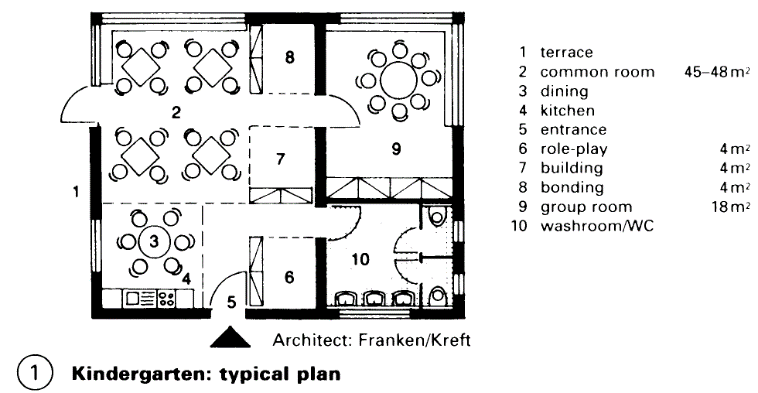Child Daycare Centres. Playgrounds
Child daycare centres provide social and educational facilities for daytime care of pre-school children and school children up to the age of 15. Children's needs should be taken into consideration in the planning. Division according to age groups:
Creche from 8 months to 3 years, groups of 6-8 children; kindergarten from 3 years to school age groups of 25-30 children; children's after-school care centre from 6-15 years, groups of 25-30 children. If possible, provision should be made for age groups to be combined. The centre should be near housing and traffic-free.
Size of rooms, schedule of accommodation and details – (1) + (2).


Creche 2-3m2 floor space/child (babies, crawlers and toddlers) plus spaces for: nappy changing table, playpens, cupboards, toy racks, child-size tables and chairs.
Kindergarten 1.5-3m2 floor space/child. 15-30 children/ room plus spaces for cupboards, toy racks, child-size tables and chairs, chalkboards, etc.
After-school care centre 1.5-4m2 floor space/child. 20 children/room plus spaces for cupboards, toy racks, child-size tables and chairs, chalkboards, storage facilities, homework room with cupboard for teaching material, shelves, desks and chairs. Arts and crafts room with cupboard for tools and materials, workbench, carpentry bench, etc.
With more than two group rooms a multipurpose room is required, preferably next to the group rooms and with a view of them. Good sound insulation, so as to help concentration in group learning processes, e.g. play rehearsals, etc.
If the room is large enough (min. 60 m2) it can also be used as a gymnasium and for afternoon naps. Apparatus store.
There is a trend towards two-storey buildings with staircases and emergency stairs, especially in high-density urban areas; and child daycare centres with longer opening hours for working or single parents (07.30 - 17.00). Facilities for disabled children, WCs and washrooms accessible to wheelchairs, therapy room. Min. 6 parking spaces and space for bicycles and prams.
Driveway and parking for staff and people collecting children, playground.
Playgrounds. Play makes a fundamental contribution to the development of a child's personality. It is mainly through play that small children adapt to their environment. Play areas must be varied, changing and changeable. They must meet children's needs. Play is a social experience, through it children learn to understand the consequences of their behaviour.
Requirements of play areas: traffic safety, no pollution, adequate sunshine, ground water level not too high.

Play areas should be focal points within residential areas and should be connected to residential and other areas by simple networks of paths. They should not be pushed out on to the periphery but planned in connection with communication systems. Guidelines for planning playgrounds take into account the following data: age group, usable space per person, play area size, distance from dwellings, etc.

When building housing, private outdoor playgrounds in the grounds of the housing complex should be provided for younger children up to the age of 6, for children from 6-12 and for adults. A basis for calculating the size of all public playgrounds can often be found in planning regulations. For example, 5m2 play area per housing unit, minimum size of playground 40 m2. Open spaces for play must be enclosed by a barrier at least 1 m high (dense hedge, fences, etc.) to protect them from roads, parked cars, railway lines, deep water, precipices and other sources of danger.
Date added: 2023-01-05; views: 589;
